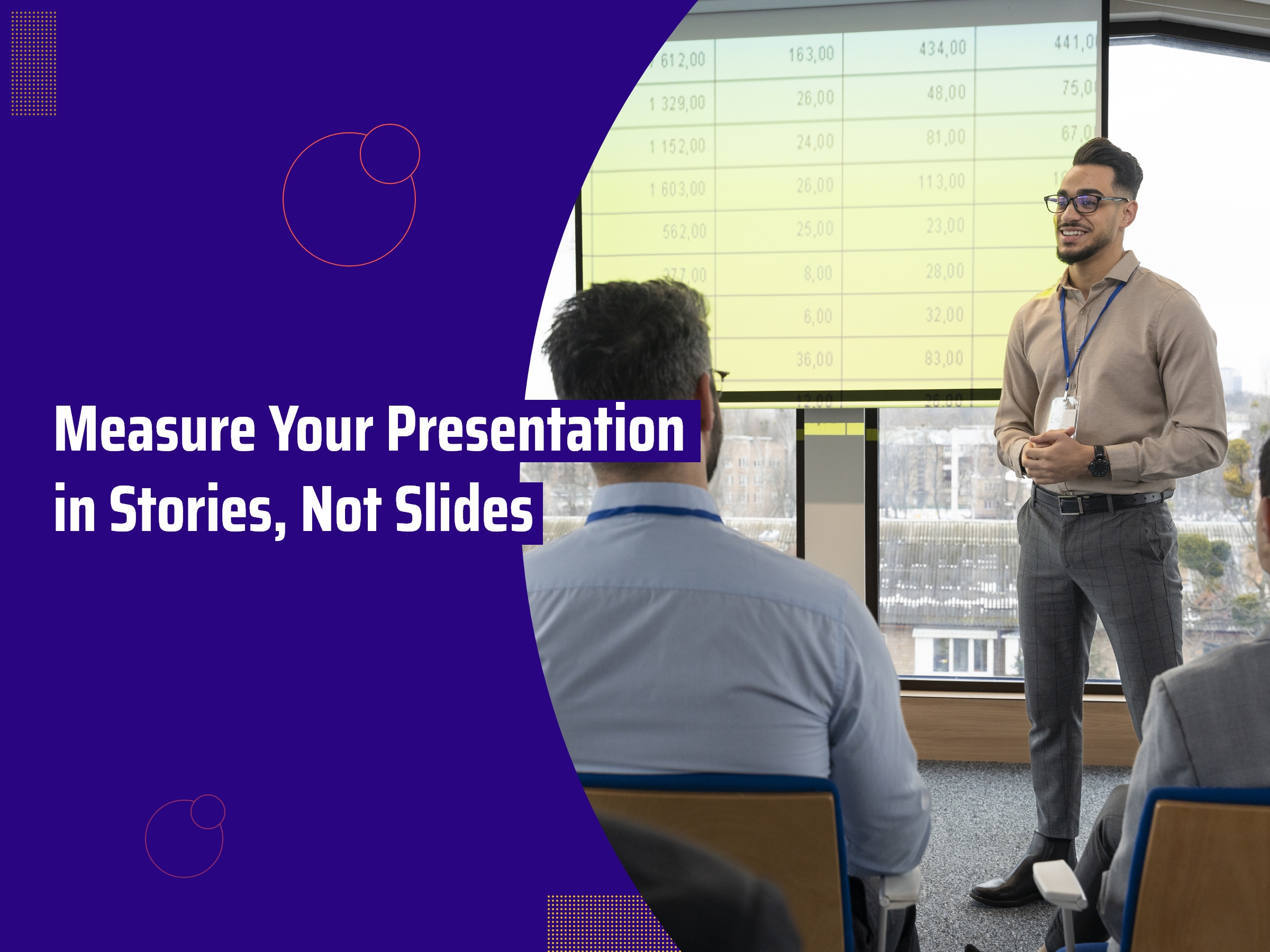Most 18-minute TED talks leave you mesmerized, captivated and even awe-struck. It is almost magical. It is not surprising that these stick to you for days, even months and sometimes even years. But what makes them so powerful presentations? It’s not just the slides or the flashy graphics that make those talks unforgettable. It’s the storytelling. And let’s be clear; storytelling isn’t just a tool, it’s an art form.
Think back to the oldest stories known to man, like the ones found in the caves of Ajanta and Ellora to Panchatantra; stories have always resonated. These are the stories that were told and retold for generations. The article focuses on the power of tales to engage audiences, build emotional connections, and leave a lasting impression.
Additionally, it covers the ideal story kinds to use in presentations as well as delivery techniques. Speakers can create presentations that move and inspire the audience by including presentation stories in their talks.
But why are stories so compelling?
It’s in our heads. Our brains are hardwired to process and store information through stories. And that’s why it is such a powerful tool in the business world. By incorporating five essential elements, you can use storytelling to captivate any audience, whether presenting a new product, pitching an idea, or simply trying to communicate a message.
But why is it that stories matter so much? Why do they resonate so much? The reason is both stories and sapiens have existed together almost simultaneously.
As humans evolved, so did the stories.
Stories have captivated us for as long as humans have existed. We have told them around campfires and passed them down generations, and even today, in a world of smartphones and ever-on internet, we still crave the power of a good tale.
What are in the stories that draw us so profoundly? It’s not just the plot or the characters, though they are essential. No, there’s something more fundamental at play here. Stories allow us to explore the human experience in a deeply personal and universally relatable way. They let us glimpse the inner workings of other minds, see the world through different eyes, and gain insight into the complexities of life.
And yet, despite their enduring popularity, storytelling is often dismissed as a frivolous pursuit, a form of entertainment that pales in comparison to the “serious” business of education or politics. But this is a shortsighted view. It is not just a means of entertainment; it’s a powerful tool for connection, understanding, and even transformation. In the context of presentations stories, can aid in bringing dry or technical material to life, increasing the audience’s retention and engagement.
People don’t connect to products, data, or companies. People relate to stories. And that’s why, when you’re giving a effective presentations, your job is to weave whatever important information you have into an account that helps people engage.
But here’s the thing to remember – stories don’t have bullet points. They have characters, actions, and emotions. These are vital ingredients that hook audiences.
What if, instead of talking about your project or product, you talk about how it has impacted real people and how it will improve your audience’s life? Get personal and relatable, and watch your audience become invested in your words.
It’s tempting to list bullet points and discuss what each one means. Here’s a tip – don’t put the bullet points on the screen. Just talk. Tell the story you want your audience to engage with. And remember, the power of storytelling doesn’t just lie in making your presentation more attractive. It’s also backed by science. Our brains are hardwired to process and store information through stories.
The Art & Science of Impactful Presentations
Many people suffer from this misplaced notion that slides must be riddled with bullet points.
NO.
It’s the STRUCTURE (or flow) that counts. Having a structure to support meaning is excellent.
This following structure is a big classic that many storytellers use.
First, you define the context so that people can start to have empathy.
Second, when your audience starts to have empathy, they are immersed in the story you are telling.
The basis for empathy is a character the public can relate to. It’s pretty hard for people to have compassion for inanimate objects. The guide focuses a strong emphasis on the value of using storytelling, or what are sometimes referred to as presentation stories to engage the audience emotionally.
Here are a few tried and tested storytelling structures for a winning presentations:
1. Problem-Resolution Structure: The Evergreen Approach
It all starts with life being friendly and accessible. But then, uh-oh, a problem arises! It’s an unfair fight, and we need a hero to come in and save the day. The hero overcomes the problem, and everything seems solved. But wait, there is a twist in the story!
There’s always a final fight, and the hero might fail. But no need to get fearful. They will appear to be losing the battle but eventually win it.
This structure is tried and true, and it’s been used countless times. It can keep your audience engaged and on the edge of their seats.
2. The Steve Jobs Structure
Do you know what every great story needs? A good old villain. And Steve Jobs knew that, too, and applied it even better. That’s why Jobs introduces the story’s villain: the problem that needs a solution.
He points out the flaws in regular cell phones and even smartphones. They’re not easy to use and are often complicated, and blah, blah!
That’s where Apple comes in—the Hero. They want to create a product that is more innovative than any other mobile device and incredibly easy to use. And with that, the iPhone is born. Jobs knew that to sell a new product; he had to make people see the problem and how his product was the solution.
For instance, in the 2007 iPhone presentation, Jobs sold the benefit of the multi-touch user interface, which was far more advanced and accurate than any other touch display that had ever been shipped. He emphasized that it was super smart, responsive to multi-finger gestures, and didn’t require a stylus. This new technology would change the way people interacted with their phones and was the key selling point of the iPhone. Jobs also pointed out that this innovation was patented, adding exclusivity and value to the product. By focusing on the benefit rather than just the features, Jobs created a compelling story that resonated with his audience and left them excited to experience the product.
By focusing on the benefits rather than features, Jobs created a sense of exclusivity and value that his audience couldn’t resist. It was the kind of innovation that could change the world; everyone in the room wanted to be a part of it. Jobs’ ability to sell the benefit made him one of the greatest marketers ever.
3. TED Structure
Carmine Gallo, the author of The Storyteller’s Secret, went above and beyond by watching 150 hours of TED talks, including 500 of the most popular ones. Through his research and interviews with successful speakers, he discovered that the discussions that really resonated with viewers had a specific structure: 65 percent personal stories, 25 percent facts and figures, and 10 percent information to establish the speaker’s credibility.
It is the personal story that made all the difference.
For example, Sheryl Sandberg’s TED Talk garnered huge appreciation. She was planning to present data on the lack of women in leadership roles, but it was her story about her 3-year-old daughter trying to prevent her from giving the TED talk that truly captivated the audience.
The Power of Belief
You can learn the power to enrapture an audience with your words. You can mesmerize them with stunning visuals. You can even hold your audience spellbound with your voice and body language. These are skills that I can help you master.
But let me tell you one secret – none of these abilities truly matters if you’re not deeply passionate about your message. Without that belief, your presentation will lack the magic that makes it truly memorable.
The speaker shows how belief can be a potent weapon for change and development in both our personal and professional life via the use of presentation stories. The presentation offers helpful advice on how to spot constricting beliefs and swap them out for empowering ones, which will ultimately lead to more fulfilment and success. This presentation is a must-watch if you want to change your own beliefs or motivate others to do the same.
No one is born with a natural talent for using a PowerPoint clicker, distilling a story’s core into a brief, compelling narrative, or visualizing and articulating it with ease. These are skills that require practice and honing over time. It’s normal to feel unsure or uncomfortable when presenting ideas, but with practice and guidance, anyone can develop the skills to deliver a compelling and memorable presentations. So, don’t be discouraged – with the right mindset and training, you can become a master at presenting ideas with confidence and flair.






